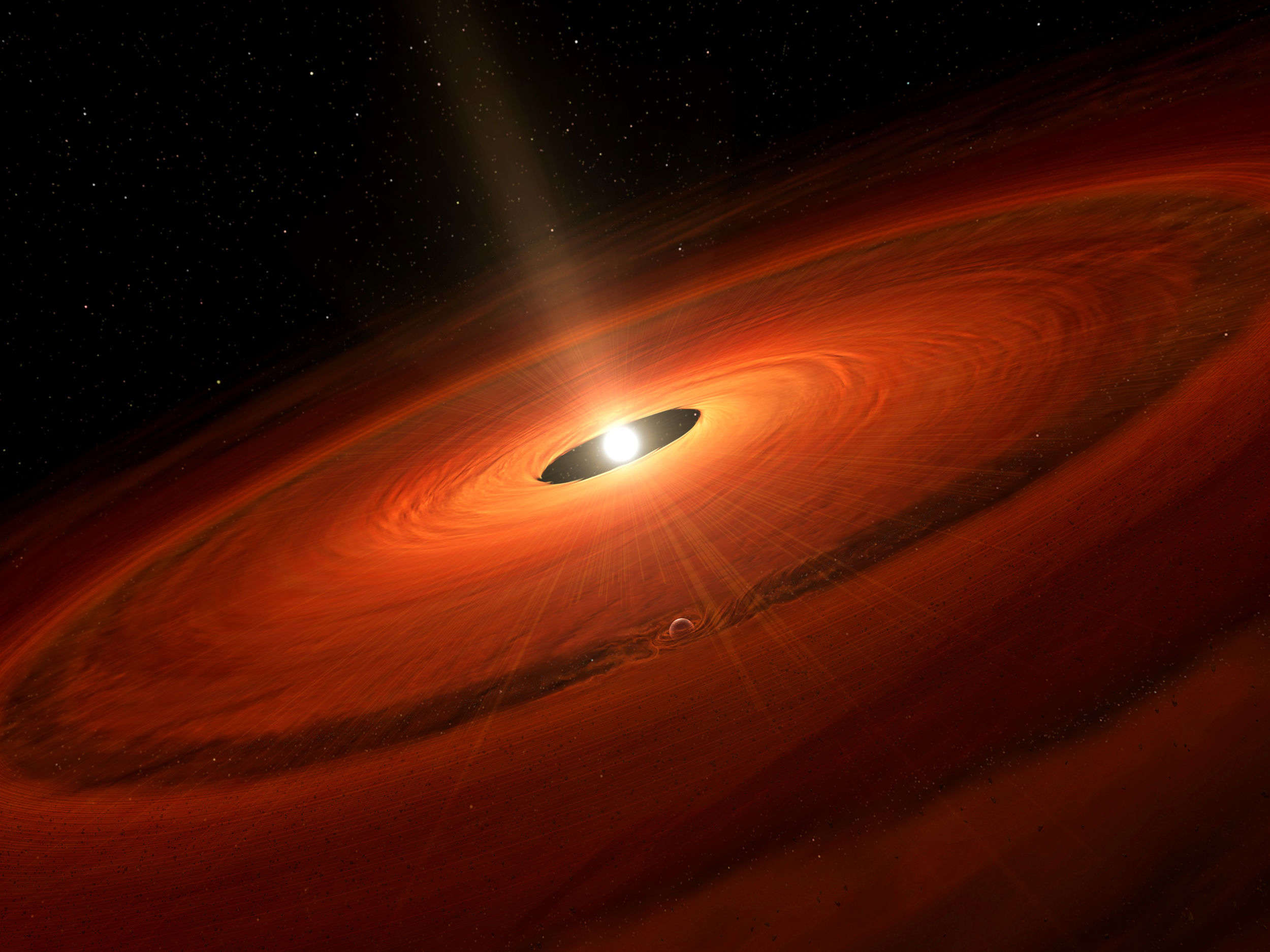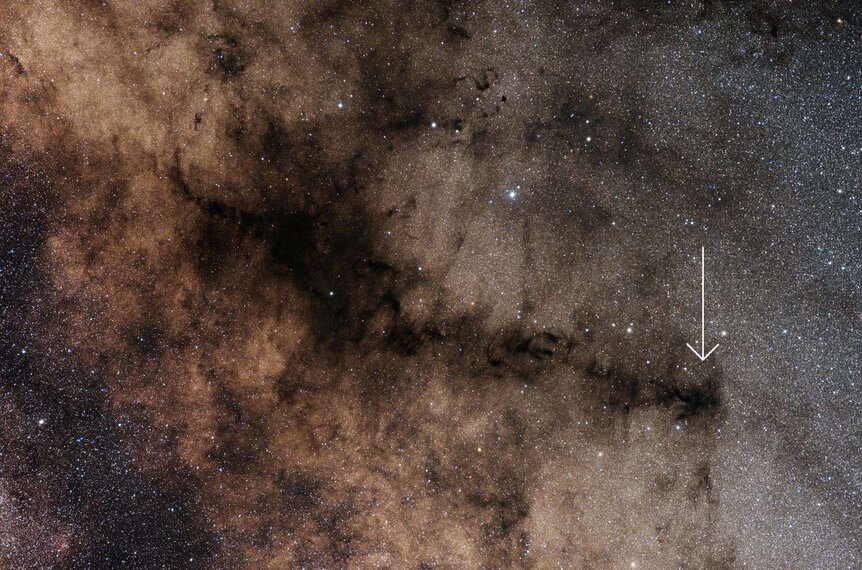Create a free profile to get unlimited access to exclusive videos, sweepstakes, and more!
A planet eats a disk while the disk eats a nebula. It’s eating all the way down

Astronomers have found what may be a very weird case of a young star and planet forming in a dense cloud of gas and dust about 500 light years away. The young system is forming in a disk, which is common enough, but in this case the disk itself appears to still be forming from gas falling into it from the surrounding nebula!
The nebula is called Barnard 59 (or B59), a dense, cold knot of gas and dust called a molecular cloud. In this case, it’s part of the remarkable Pipe Nebula, a complex of dark nebulae that appear to form the shape of a pipe; B59 is the tip of the stem of the pipe. It’s the only part of the complex that is forming stars in it, with several newborn stars taking shape deep inside.
The astronomers wanted to investigate those stars, so they used the Atacama Large Millimeter/submillimeter Array (ALMA) and the Very Large Array, which observe in wavelengths that can get out of the cloud and to us; dust that thick stops visible light completely, absorbing it all.
The star itself is pretty much what you’d expect. It appears to be less than a million years old, glowing brightly 1.7 times the Sun’s brightness, and has a mass of over twice the Sun’s, so when it’s done forming it’ll be a decently beefy star.
It’s centered in a large disk of gas and dust that we see very nearly but not quite edge-on, tilted by just 15° to our line of sight. The disk reaches over 15 billion kilometers from the star (Neptune is about 4.5 billion km out from the Sun, for comparison). There’s a large gap in the disk about 10 billion km wide, centered about 7.5 billion kilometers out from the star.
It’s common to see gaps in disks around young stars, and there can be several sources for them, but the most common is a big ol’ planet in there, carving the gap as it draws material from the disk into itself by its gravity.
Supporting that is a hot spot of gas seen by ALMA right in the middle of the gap on one side of the star. VLA sees something there as well, a marginally detected blob of energy that is “non-thermal,” meaning it’s not from something that’s just being hot. In general that usually means there’s a strong magnetic field at play, and it’s accelerating charged particles to high speed.
That all fits together with a planet. The astronomers use various models of the structure, gas, and dust to estimate that if that blob is a planet, it has a mass somewhere between 4 and 70 times that of Jupiter. That’s massive enough to make that gap, and planets that size can spin very rapidly, have strong magnetic fields, and blast out beams of matter that would explain the VLA detection. Very young planets are also pretty hot, so it would heat the gas and explain the ALMA observation as well.
Again, nothing too controversial there. Where this gets weird is when the view widens. Looking much farther out from the disk, ALMA sees two huge and narrow filaments of gas coming from Barnard 59 and connecting right into the disk. Each filament is incredibly long, over 600 billion kilometers!
The observatory can also measure the velocity of the gas, and finds that the northern (upper) filament is redshifted, heading away from us, and the southern one is blueshifted, heading toward us.
The disk itself is rotating, orbiting the star, and ALMA can see that as well. And what it sees is that the redshifted filament seems to connect to the redshifted side of the disk, and the blueshifted filament to the disk’s blueshifted side. In other words, that’s all consistent, as if the gas is flowing down into the disk from the nebula, feeding it. Like a… pipeline*.
Well, nothing like that has ever been seen before: A disk that’s forming a star and planet even while the disk itself is still growing. Usually the disk is isolated by the time a planet is forming inside it. So that’s pretty odd.
Having said all that, it’s possible the second blob isn’t a planet. It’s awfully far from the star, and planets that massive don’t usually form in a disk that far out. I should note too that at the upper end of the mass range it may not actually be a planet at all, but a brown dwarf, a class of objects more massive than planets but less than stars. Those are thought to generally form directly from the nebular gas and not in a star’s disk, so that’s a bit weird too.
And finally all of this is unusual to see in a system so young. Jupiter-mass planets have been seen forming at such a young age, but it’s rare. And this one is much more massive than Jupiter — meaning it would have had to grow fast — so add that to the list of oddities.
Of course, the paper ends with the standard astronomer’s lament: More observations are needed. That could help determine if the second blob is real and, if so, whether it’s actually a planet or brown dwarf, and could nail down more information about the disk and the filaments.
This is clearly a pretty unusual system, and it would be nice to understand just why it’s doing what it’s doing.
*From the Pipe Nebula! I love it when the Universe itself makes a pun.

![Observations of [BHB 2007] 1 show a hot spot in gas (left), as well as energy coming from a source nearby that may be a planet with a strong magnetic field (middle). A schematic of the disk (right) shows the proposed structure of the disk with its gap, an](/sites/syfy/files/styles/scale_600/public/bhb2007_disk_schematic.jpeg)
![ALMA and VLA observations of the still-forming star [BHB 2007] 1 show it’s surrounded by a disk with a gap carved in it, possibly by a planet (right). Remarkably, there are also huge filaments of gas apparently feeding the disk from the surrounding nebula](/sites/syfy/files/styles/scale_862/public/bhb2007_disk_filament.jpg)



























